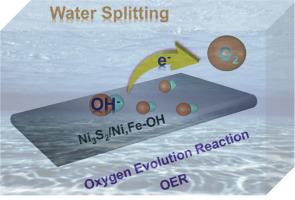High-Efficiency Electrocatalytic Splitting of water/seawater Enabled by Ni3S2 Nanosheets Anchored on Amorphous Ni,Fe-OH with Enhanced Electron Transfer
IF 5.6
3区 材料科学
Q1 ELECTROCHEMISTRY
引用次数: 0
Abstract
Water electrolysis holds significant potential for advancing the establishment of a viable green hydrogen ecosystem. However, its widespread industrial application is severely hindered by the sluggish kinetics of catalytic reactions. Enhancing the electron transfer efficiency of electrocatalysts is crucial for accelerating the kinetics of the oxygen evolution reaction (OER). To address this, a heterojunction catalyst composed of Ni3S2 nanosheets anchored on an amorphous Ni,Fe-OH surface was fabricated on nickel foam (NF). The Ni3S2/Ni,Fe-OH catalyst exhibits an exceptionally low Tafel slope (65.3 mV dec-1) and an overpotential of 412 mV at 500 mA cm⁻². Moreover, it demonstrates outstanding long-term stability across a wide current density range of 0.05-2 A cm⁻², in both water and simulated seawater splitting. Density functional theory (DFT) calculations reveal that the higher partial density of states (PDOS) of the Ni3S2 catalyst facilitates accelerated electron transfer to the amorphous Ni,Fe-OH. Mechanism study identifies NiOOH as the active intermediate during the OER process. This research highlights the considerable promise of heterojunctions formed between crystalline and amorphous structures in catalysts for water and seawater electrolysis.

Ni3S2纳米片锚定在非晶Ni,Fe-OH上的高效电催化分解水/海水
水电解在推进建立可行的绿色氢生态系统方面具有巨大的潜力。然而,催化反应动力学缓慢严重阻碍了其广泛的工业应用。提高电催化剂的电子传递效率是加快析氧反应动力学的关键。为了解决这个问题,在泡沫镍(NF)上制备了一种由Ni3S2纳米片组成的异质结催化剂,该催化剂锚定在非晶Ni,Fe-OH表面上。Ni3S2/Ni,Fe-OH催化剂表现出极低的塔菲尔斜率(65.3 mV -1)和在500 mA cm - 2时的过电位为412 mV。此外,在水和模拟海水分裂中,它在0.05-2 a cm(⁻²)的宽电流密度范围内表现出出色的长期稳定性。密度泛函理论(DFT)计算表明,Ni3S2催化剂较高的偏态密度(PDOS)有利于加速电子向非晶Ni,Fe-OH的转移。机理研究表明NiOOH是OER过程中的活性中间体。这项研究强调了在水和海水电解催化剂中晶体和非晶态结构之间形成异质结的巨大前景。
本文章由计算机程序翻译,如有差异,请以英文原文为准。
求助全文
约1分钟内获得全文
求助全文
来源期刊

Electrochimica Acta
工程技术-电化学
CiteScore
11.30
自引率
6.10%
发文量
1634
审稿时长
41 days
期刊介绍:
Electrochimica Acta is an international journal. It is intended for the publication of both original work and reviews in the field of electrochemistry. Electrochemistry should be interpreted to mean any of the research fields covered by the Divisions of the International Society of Electrochemistry listed below, as well as emerging scientific domains covered by ISE New Topics Committee.
 求助内容:
求助内容: 应助结果提醒方式:
应助结果提醒方式:


